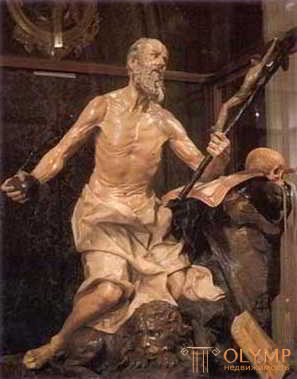
1. Overview of the development of Spanish sculpture of the 18th century
The lush altars in the style of Hurrigvere, which in the first half of this century were decorated with many Spanish churches, with their rich sculptural decoration, consisting of figures of saints, choirs of angels and relief images, in combination with fanciful ornamentation, were equally works of architecture and plastics. Their authors were also often architects, sculptors and painters at the same time. Narsizo Tomi, master of the famous “Trasparente” of the Toledo Cathedral, celebrated as the eighth wonder of the world, praises in the inscription that he not only composed himself, but also carved and painted this amazing, albeit anti-artistic work made of marble, jasper and bronze. Pedro Ribera, also a well-known architect, reaches the height of his creativity in the spirit of hurrigurism only in the portal of Madrid “Ospisio”, where plastic decoration completely supersedes architectural forms. The facade and altars of the Cathedral of Saint-Yago de Compostela were also decorated with lush stone sculptures, in the shapes of figures following most of the international baroque. It is customary to talk about the sculpture school of Sant Jago. Consideration of it, however, would not give us significant results.
More important are the scions of the Old Spanish polychrome wooden plastics, the masters of which for the most part were engaged in simultaneously sculpting from stone. The last representative of a prominent Andalusian school was Pedro Cornejo (1677–1757), a student of Roldan. In some cases, Hurrigiverism, for example in the benches of the choir of the cathedral in Cordoba, richly decorated with relief frames and finished in 1757, approaches the French Rococo.
A new South Hispanic school has flourished now in Murcia. Its main representative, Francisco Zarsillo-and-Alcaras (1707-1781), was at the same time the most prominent Spanish master of his time in the field of national wooden plastics. The simplicity and naturalness of the highly mobile figures, the expressiveness of their features and movements are almost unheard of for the 18th century. Almost all of his works are in south-eastern Spain, most of which are in Murcia itself, among them a figure full of passionate agitation Jerome in the church of Hermita de Jesus, others in Cartagena, Alicante and Almeria. The most significant of his works are wooden carved, painted groups of the Passion of the Lord in the church of Hermitbut Jesus in Murcia. They are appreciated by Gendke, while Gyulafua puts them not particularly high. To the most expressive of these groups belongs the Prayer of the Chalice, the Kiss of Judas, also rarely depicted with such fascinating power and at the same time as calmly as here.

Fig. 226. St. Jerome. Wooden sculpture of Francisco Zarsillo-i-Alcaras in the church of Hermite de Jesus in Murcia
Likewise, the school of Gregorio Hernandez, who migrated from Valladolid to Madrid, experienced a secondary heyday here in the 18th century. From the workshop of the brothers Juan and Alonso Ron, representing the Spanish national sculpture in Madrid in the first quarter of this century, came Lüis Salvador Carmona (1709–1767), the first professor of sculpture at the Academy of San Fernando, founded in 1752. Madrid is replete with stone and wooden sculptures of his work whose deliberately academic style shows a certain desire for strong forms. The most attractive are his works in the Cathedral of Salamanca: strict and important, but devoid of internal expression of the Grieving Mother of God with an excellent dead Savior on her knees and the Flagellation of Christ, where the forms of the Savior’s body are covered with blood streams.
A disciple of Carmona Francisco Gutierrez (1727–1782) developed in the direction of more strict classicism, whose marble figures and reliefs on the funeral monument of Ferdinand VI built by Sabatini in Madrid’s Salezas Reales church excited the delight of purer tastes. The real culprit of the turn in the direction of classicism was, as we have seen, not one of the Spanish masters, but the Italian Canova.
Что бы оставить комментарий войдите
Комментарии (0)